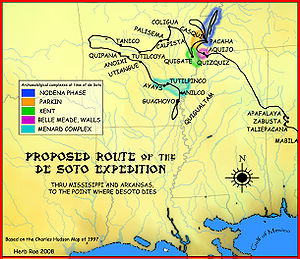
Menard-Hodges Site
Encyclopedia

Archaeological site
An archaeological site is a place in which evidence of past activity is preserved , and which has been, or may be, investigated using the discipline of archaeology and represents a part of the archaeological record.Beyond this, the definition and geographical extent of a 'site' can vary widely,...
in Arkansas
Arkansas
Arkansas is a state located in the southern region of the United States. Its name is an Algonquian name of the Quapaw Indians. Arkansas shares borders with six states , and its eastern border is largely defined by the Mississippi River...
. It includes two large mounds as well as several house mounds. It is the type site
Type site
In archaeology a type site is a site that is considered the model of a particular archaeological culture...
for the Menard phase, a protohistoric
Protohistory
Protohistory refers to a period between prehistory and history, during which a culture or civilization has not yet developed writing, but other cultures have already noted its existence in their own writings...
Mississippian culture
Mississippian culture
The Mississippian culture was a mound-building Native American culture that flourished in what is now the Midwestern, Eastern, and Southeastern United States from approximately 800 CE to 1500 CE, varying regionally....
group. It is considered as a possible candidate for the Province of Anilco encountered by the Hernando de Soto Entrada in 1540. It was contemporaneous with the Parkin site
Parkin Archeological State Park
Parkin Archeological State Park, also known as Parkin Indian Mound, is an archeological site and state park in Parkin, Cross County, Arkansas. Around 1350–1650 CE an aboriginal palisaded village existed at the site, at the confluence of the St. Francis and Tyronza Rivers. Artifacts from this...
, believed by many archaeologists to be the location Casqui
Casqui
Casqui was a Native American tribe discovered in 1541 by the Hernando de Soto expedition. This tribe inhabited fortified villages in eastern Arkansas....
, and the Nodena Site
Nodena Site
The Nodena Site is an archeological site east of Wilson, Arkansas and northeast of Reverie, Tennessee in Mississippi County, Arkansas, United States. Around 1400–1650 CE an aboriginal palisaded village existed in the Nodena area on a meander bend of the Mississippi River. The Nodena site...
, believed by many archaeologists to be the location of Pacaha
Pacaha
Pacaha was a Native American tribe encountered in 1541 by the Hernando de Soto expedition. This tribe inhabited fortified villages in what is today the northeastern portion of the U.S. state of Arkansas...
.
The site was excavated by James A. Ford
James A. Ford
James Alfred Ford was an American archaeologist. He was born in Water Valley, Mississippi, on February 12, 1911. He became interested in work on Native American mound research while growing up in Mississippi.-Archaeological work:...
in 1958. The excavations included burials, with graves in extended, flexed, and secondary interments scattered throughout the site and oriented in many different directions. The site was declared a National Historic Landmark
National Historic Landmark
A National Historic Landmark is a building, site, structure, object, or district, that is officially recognized by the United States government for its historical significance...
in 1989.
See also
- Mississippian cultureMississippian cultureThe Mississippian culture was a mound-building Native American culture that flourished in what is now the Midwestern, Eastern, and Southeastern United States from approximately 800 CE to 1500 CE, varying regionally....
- List of Mississippian sites
- List of sites and peoples visited by the Hernando de Soto Expedition
- History of the Tunica people

